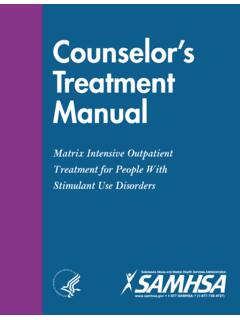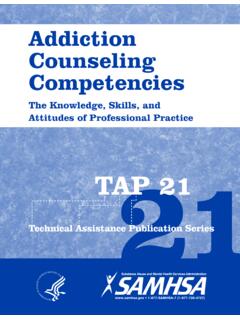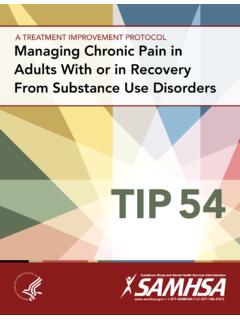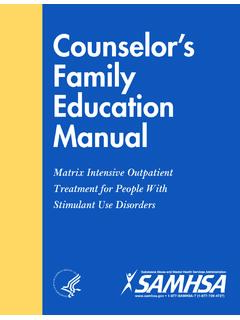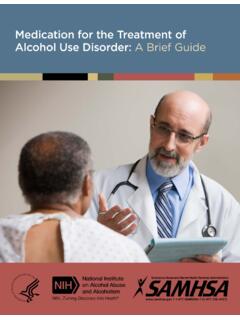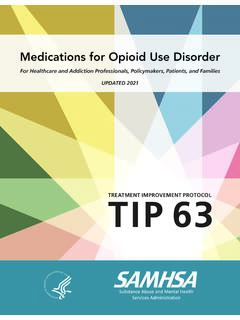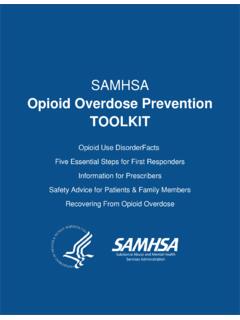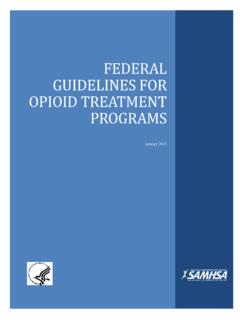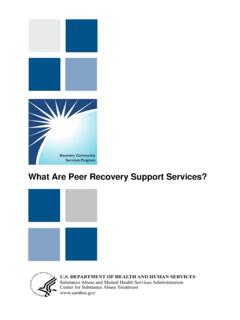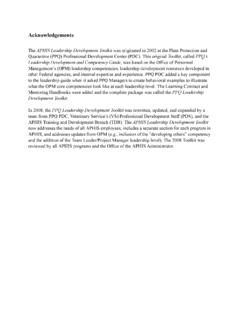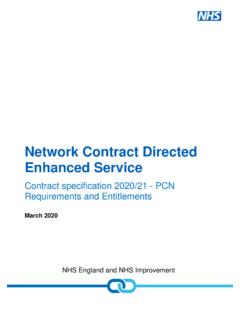Transcription of COMPREHENSIVE CASE MANAGEMENT FOR SUBSTANCE …
1 SUBSTANCE Abuse and Mental HealthServices AdministrationADVISORYPage 1 of 10 COMPREHENSIVE CASE MANAGEMENT FOR SUBSTANCE USE DISORDER TREATMENT The definition of case MANAGEMENT varies by setting, but in general terms it is a coordinated, individualized approach that links patients1 with appropriate services to address their specific needs and help them achieve their stated goals. Case MANAGEMENT for patients with SUBSTANCE use disorders (SUDs) has been found to be effective because it helps them stay in treatment and recovery. Also, by concurrently addressing other needs, it allows patients to focus on SUD treatment.
2 The types of settings offering SUD case MANAGEMENT include specialty treatment programs, federally qualified health centers, rural health centers, community mental health centers, veterans health programs, and integrated primary care practices. This Advisory is based on the SUBSTANCE Abuse and Mental Health Services Administration s (SAMHSA) Treatment Improvement Protocol (TIP) 27, COMPREHENSIVE Case MANAGEMENT for SUBSTANCE Abuse Treatment. It surveys the underlying principles and models of case MANAGEMENT , discusses reasons SUD treatment providers might consider implementing or expanding the use of case MANAGEMENT , and lists some case MANAGEMENT -related resources and tools.
3 Key Messages Case MANAGEMENT is framed around screening to identify a patient s medical, psychosocial, behavioral, and functional needs, and then working directly and/or through community resources to address these needs while the SUD is treated. Case MANAGEMENT is increasingly used to support treatment engagement and retention while reducing the impact of SUDs on the community. The SUD treatment program can select a case MANAGEMENT model that matches its treatment approach and best suits its patients and the service setting. In any type of case MANAGEMENT model employed, all care team members should contribute to and endorse the patient s treatment plan , and effectively communicate with each other as the plan is implemented.
4 Case MANAGEMENT Overview The percentage of SUD treatment programs using case MANAGEMENT has risen since 2000, from 66 percent of the 13,418 facilities then in operation to 83 percent of the 15,961 facilities operating in 2019 (SAMHSA, 2020c; SAMHSA, Office of Applied Studies, 2002). 1 This publication uses only the term patients to describe recipients or potential recipients of case MANAGEMENT services. In practice, depending on the setting and the context, the terms clients or participants are also frequently used. ADVISORY 1 2 4 Seek your patient s participation.
5 Help your patient explore & compare Assess your patient s Reach a 3 5 treatment values & decisionoptions. preferences. Evaluatewith your your patient s patient. decision. Definitive statements about the overall effectiveness of case MANAGEMENT cannot be made, because studies vary in their definitions of the term, methodology, study populations, intervention designs, and outcome measures. However, multiple analyses (Joo & Huber, 2015; Kirk et al., 2013; Penzenstadler et al., 2017; Rapp et al., 2014; Regis et al., 2020) have found positive outcomes for one or more measures, such as treatment adherence, overall functioning, costs, decreases in SUBSTANCE use, reductions in acute care episodes, and increased engagement in nonacute services.
6 A 2019 meta-analysis comparing case MANAGEMENT with treatment as usual showed a small yet statistically significant positive effect, which was greater for treatment-related tasks than for personal functioning outcomes such as improved health status and family relations and reductions in SUBSTANCE use and legal involvement (Vanderplasschen et al., 2019). Principles of case MANAGEMENT It offers the patient a single point of contact with the health and social services system. The case manager assumes responsibility for coordinating the care of patients who receive services from multiple agencies.
7 This replaces a haphazard process of referrals with a single, more well structured service. It is patient centered. Each patient s right to self-determination is emphasized. The case manager is familiar with the patient s experiences and world, and uses this understanding to identify psychosocial stressors and anticipate needs. The case manager works with the patient to set reasonable goals (see box) and helps the patient access the chosen services. Shared Decision Making One aspect of patient-centered care is using shared decision making rather than a directive approach with patients.
8 Shared decision making is an emerging best practice that aims to help people in treatment and recovery have informed, meaningful, and collaborative discussions with providers (SAMHSA, 2020d) about the behavioral healthcare services they receive. The federal Agency for Healthcare Research and Quality (AHRQ) has developed a five-step process for shared decision making and resources for implementing it. 5 Essential Steps of Shared Decision Making Adapted from material in the public domain. It is community based. The case manager helps the patient access and integrate formalized and informal care services, overcome barriers to services, and transition between services.
9 Case managers vary in how much they are directly involved with community services ( , whether they make warm handoffs or accompany patients to meetings). Page 2 of 10 SAMHSA s mission is to reduce the impact of SUBSTANCE abuse and mental illness on America s communities. 1-877-SAMHSA-7 | (1-877-726-4727) 1-800-487-4889 (TDD) ADVISORY It is equity driven. Typically, the case manager begins by addressing a patient s urgent and tangible needs, such as stable and safe housing, food, child care, or income. The case manager does this work recognizing that when viewed through a social determinants of health (SDOH) lens (see box), some populations disproportionately lack such life-enhancing resources and that for some patients, access to one or more of these resources may be a prerequisite for focusing on treatment.
10 It involves advocacy. The case manager promotes the patient s best interests. This can Social Determinants of Health SDOH have been defined as the conditions in the environments where people are born, live, learn, work, play, worship, and age that affect a wide range of health, functioning, and quality-of-life outcomes and risks ( Department of Health and Human Services, ), including risk for SUBSTANCE misuse and related health consequences (Office of the Surgeon General, 2016). Case managers can play a central role in assessing SDOH and in assisting to develop a plan that effectively takes them into account (Fink-Samnick, 2018).
